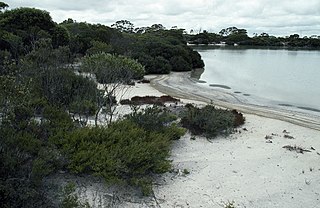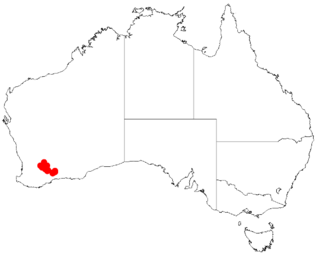| Rinzia carnosa | |
|---|---|
| Scientific classification | |
| Kingdom: | Plantae |
| Clade: | Angiosperms |
| Clade: | Eudicots |
| Clade: | Rosids |
| Order: | Myrtales |
| Family: | Myrtaceae |
| Genus: | Rinzia |
| Species: | R. carnosa |
| Binomial name | |
| Rinzia carnosa | |
Rinzia carnosa, commonly known as the fleshy leaved rinzia, is a plant species of the family Myrtaceae endemic to Western Australia. [1]
In biology, a species is the basic unit of classification and a taxonomic rank of an organism, as well as a unit of biodiversity. A species is often defined as the largest group of organisms in which any two individuals of the appropriate sexes or mating types can produce fertile offspring, typically by sexual reproduction. Other ways of defining species include their karyotype, DNA sequence, morphology, behaviour or ecological niche. In addition, paleontologists use the concept of the chronospecies since fossil reproduction cannot be examined.

Myrtaceae or the myrtle family is a family of dicotyledonous plants placed within the order Myrtales. Myrtle, pohutukawa, bay rum tree, clove, guava, acca (feijoa), allspice, and eucalyptus are some notable members of this group. All species are woody, contain essential oils, and have flower parts in multiples of four or five. The leaves are evergreen, alternate to mostly opposite, simple, and usually entire. The flowers have a base number of five petals, though in several genera the petals are minute or absent. The stamens are usually very conspicuous, brightly coloured and numerous.

Endemism is the ecological state of a species being unique to a defined geographic location, such as an island, nation, country or other defined zone, or habitat type; organisms that are indigenous to a place are not endemic to it if they are also found elsewhere. The extreme opposite of endemism is cosmopolitan distribution. An alternative term for a species that is endemic is precinctive, which applies to species that are restricted to a defined geographical area.
The woody sub-shrub typically grows to a height of 0.7 to 1.3 metres (2.3 to 4.3 ft). [1] It has many branches with long slim branchlets. The thick, appressed and pitted leaves have a elliptic to sub-orbicular shape with a length of 0.5 to 2.5 millimetres (0.020 to 0.098 in) and a width of 0.5 to 1 mm (0.020 to 0.039 in). [2] It blooms in September producing white-pink flowers. [1] The flowers are 5 to 7 mm (0.197 to 0.276 in) in diameter with five petals and occur in clusters at the end of the branchlets. [2]
It is found in the south eastern Wheatbelt and the Goldfields-Esperance regions of Western Australia between Corrigin and Jerramungup where it grows in sandy-loamy soils often over granite. [1] The plant is usually part of the understorey in thickets of Acacia shrub communities. [2]

The Wheatbelt is one of nine regions of Western Australia defined as administrative areas for the state's regional development, and a vernacular term for the area converted to agriculture during colonisation. It partially surrounds the Perth metropolitan area, extending north from Perth to the Mid West region, and east to the Goldfields-Esperance region. It is bordered to the south by the South West and Great Southern regions, and to the west by the Indian Ocean, the Perth metropolitan area, and the Peel region. Altogether, it has an area of 154,862 square kilometres (59,793 sq mi).

The Goldfields-Esperance region is one of the nine regions of Western Australia. It is located in the south eastern corner of Western Australia, and comprises the local government areas of Coolgardie, Dundas, Esperance, Kalgoorlie-Boulder, Laverton, Leonora, Menzies, Ngaanyatjarraku and Ravensthorpe.

Western Australia is a state occupying the entire western third of Australia. It is bounded by the Indian Ocean to the north and west, and the Southern Ocean to the south, the Northern Territory to the north-east, and South Australia to the south-east. Western Australia is Australia's largest state, with a total land area of 2,529,875 square kilometres, and the second-largest country subdivision in the world, surpassed only by Russia's Sakha Republic. The state has about 2.6 million inhabitants – around 11 percent of the national total – of whom the vast majority live in the south-west corner, 79 per cent of the population living in the Perth area, leaving the remainder of the state sparsely populated.
The species was originally formally described as Baeckea carnosa by the botanist S.Moore in 1920 in the work A contribution to the Flora of Australia. in the Journal of the Linnean Society . It was subsequently reclassified into the genus Rinzia in 1986 as part of the work Reinstatement and revision of Rinzia Schauer (Myrtaceae, Leptospermeae, Baeckeinae) in the journal Nuytsia. [3]

The Botanical Journal of the Linnean Society is a scientific journal publishing original papers relating to the taxonomy of all plant groups and fungi, including anatomy, biosystematics, cytology, ecology, ethnobotany, electron microscopy, morphogenesis, palaeobotany, palynology and phytochemistry.

Rinzia is a genus of flowering plants in the family Myrtaceae. The genus was first formally described in 1843 and reinstated and revised in 1986. The entire genus is endemic to Western Australia.
Nuytsia is a peer-reviewed scientific journal published by the Western Australian Herbarium. It publishes papers on systematic botany, giving preference to papers related to the flora of Western Australia. Nearly twenty percent of Western Australia's plant taxa have been published in Nuytsia. The journal was established in 1970 and has appeared irregularly since. The editor-in-chief is Kevin Thiele.


